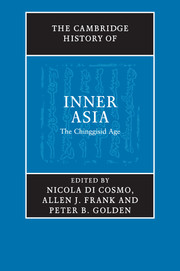Book contents
- Frontmatter
- Contents
- List of figure and maps
- List of contributors
- Note on transliteration
- List of abbreviations
- Maps
- Introduction
- PART ONE THE RISE OF THE CHINGGISIDS
- Part Two LEGACIES OF THE MONGOL CONQUESTS
- 5 Institutional development, revenues and trade
- 6 Migrations, ethnogenesis
- 7 Islamization in the Mongol Empire
- 8 Mongols as vectors for cultural transmission
- Part Three CHINGGISID DECLINE: 1368–c. 1700
- Part Four NOMADS AND SETTLED PEOPLES IN INNER ASIA AFTER THE TIMURIDS
- Part Five NEW IMPERIAL MANDATES AND THE END OF THE CHINGGISID ERA (18th–19th CENTURIES)
- Bibliography
- Index
8 - Mongols as vectors for cultural transmission
from Part Two - LEGACIES OF THE MONGOL CONQUESTS
Published online by Cambridge University Press: 05 March 2014
- Frontmatter
- Contents
- List of figure and maps
- List of contributors
- Note on transliteration
- List of abbreviations
- Maps
- Introduction
- PART ONE THE RISE OF THE CHINGGISIDS
- Part Two LEGACIES OF THE MONGOL CONQUESTS
- 5 Institutional development, revenues and trade
- 6 Migrations, ethnogenesis
- 7 Islamization in the Mongol Empire
- 8 Mongols as vectors for cultural transmission
- Part Three CHINGGISID DECLINE: 1368–c. 1700
- Part Four NOMADS AND SETTLED PEOPLES IN INNER ASIA AFTER THE TIMURIDS
- Part Five NEW IMPERIAL MANDATES AND THE END OF THE CHINGGISID ERA (18th–19th CENTURIES)
- Bibliography
- Index
Summary
For more than a century, the place of the Mongolian Empire in world history has provoked intense debate, much of it heavily coloured by national sentiment and the dictates of official ideology To some, the Mongolian onslaught was a regressive force in human history, one that ‘retarded’ the natural development of the numerous civilized societies that fell under their control. Others, in contrast, have celebrated the Mongols' religious tolerance and their political unification of large parts of the Eurasian landmass, thereby facilitating East–West communications. But whatever face of empire one chooses to emphasize, Pax Mongolica or ‘Tartar Yoke’, there can be no doubt that the Chinggisids did in fact greatly intensify cultural and commercial contact throughout the continent. While some of these contacts certainly came about as unintended consequences of their explosive expansion, many of the long-distance exchanges can be linked directly to imperial policies designed to further military conquest, enhance political prestige or satisfy native cultural tastes. In tracing this transcontinental cultural traffic, we start with particulars and then turn to general issues of explanation and interpretation.
Transport of people
Culture, of course, can be transmitted by various means, through objects, texts or direct human agency Normally all forms are present and in play but in the Mongolian era the movement of peoples, the frequent and forced resettlement of communities from one cultural zone of the empire to another, assumed a special importance.
- Type
- Chapter
- Information
- The Cambridge History of Inner AsiaThe Chinggisid Age, pp. 135 - 154Publisher: Cambridge University PressPrint publication year: 2009
- 8
- Cited by

